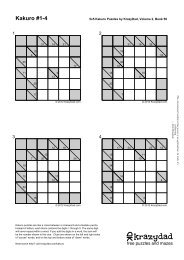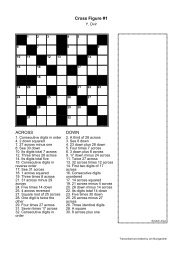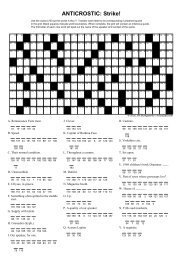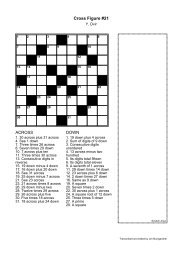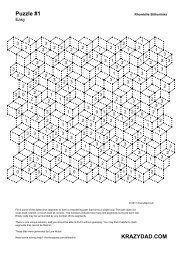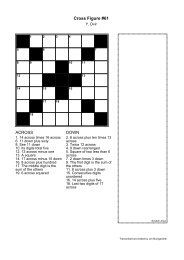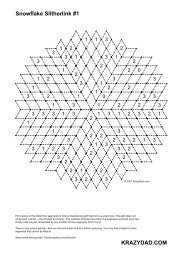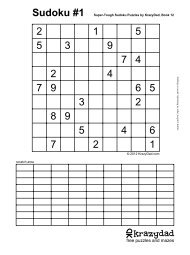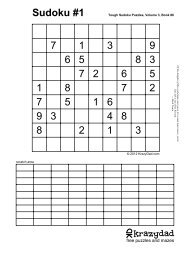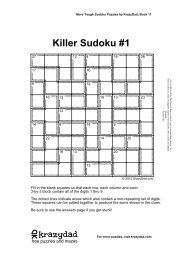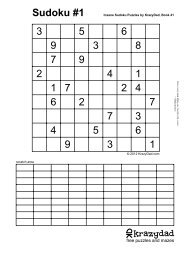The Whitney Music Box - KrazyDad
The Whitney Music Box - KrazyDad
The Whitney Music Box - KrazyDad
Create successful ePaper yourself
Turn your PDF publications into a flip-book with our unique Google optimized e-Paper software.
An early intuition about how to control total dynamics led me to activate all graphics elements<br />
through a motion function that advances each element differentially. For example, if one element<br />
were set to move at a given rate, the next element might be moved two times that rate. <strong>The</strong>n the<br />
third would move at three times that rate and so on. Each element would move at a different rate<br />
and in a different direction within the field of action. So long as all elements obey a rule of<br />
direction and rate, and none drifts about aimlessly or randomly, then pattern configurations form<br />
and reform. This is harmonic resonance and it echoes musical harmony, stated in explicit terms.<br />
I tried this procedure in several films, and was gratified by the consistency of the confirmation it<br />
demonstrated.<br />
– John <strong>Whitney</strong>, Digital Harmony, pp. 38<br />
<strong>The</strong> <strong>Whitney</strong> <strong>Music</strong> <strong>Box</strong><br />
In the book, <strong>Whitney</strong> goes on to describe a few simple examples of this type of motion. <strong>The</strong> book<br />
contains sample code in the back, in the BASIC programming language. One of those examples is<br />
constructed of points moving around a series of increasingly wider concentric circlular paths.<br />
I noticed the resemblence of the circular paths to the dots on the disc of a music box, and thought it would<br />
be interesting to use <strong>Whitney</strong>'s dots to trigger a series of notes on a chromatic scale. Although this<br />
arrangement is very similar to a regular music box equipped with chromatically tuned tines, the rotational<br />
speed of the dots differs in a way that can't be produced with a single disc - rather such a music box<br />
would require a single disc or cylindar for each dot, each moving at a slightly faster speed.<br />
Much like <strong>Whitney</strong>, I was "gratified" by the quality of<br />
the music this system generated, and even more so by<br />
the effect of listening to the music while watching the<br />
animation that triggered it [Figure 1]. What to the ear<br />
sounds like a complex piece of music becomes more<br />
lucid when the eyes are confronted with the evidence of<br />
a relatively simple and predictable system of motions<br />
triggering those sounds. <strong>The</strong> overall effect can<br />
produce a strong sense of wonderment in the listener /<br />
viewer, which I found pleasing.<br />
I went on to produce a series of variations of this basic<br />
experiment, using different numbers of dots, tunings<br />
(both chromatic, harmonic, and modal, with forward<br />
and retrograde assignments) as well as a few different<br />
methods of sound production.<br />
Figure 1 :<br />
<strong>The</strong> <strong>Whitney</strong> <strong>Music</strong> <strong>Box</strong><br />
A close inspection of <strong>Whitney</strong>'s writings reveals that he was much more of an artist than a mathematician.<br />
<strong>The</strong> mathematics of <strong>Whitney</strong>'s movies can be quite simple, based on nothing more than the simple integer<br />
ratios of Pythagoras. Like medieval music theorists, <strong>Whitney</strong> believed that the appeal of his animations,<br />
like the appeal of tonal music, was based on these simple ratios.<br />
For the casual mathematician, and casual listener, the <strong>Whitney</strong> <strong>Music</strong> <strong>Box</strong> provides a beautiful and<br />
fascinating introduction to some elementary and beautiful mathematical ideas.<br />
For more information about this project, including an online Flash demonstration, visit<br />
http://www.coverpop.com/whitney/



